Research ArticleAdult Brain
Open Access
Perivascular Spaces in Old Age: Assessment, Distribution, and Correlation with White Matter Hyperintensities
A. Laveskog, R. Wang, L. Bronge, L.-O. Wahlund and C. Qiu
American Journal of Neuroradiology January 2018, 39 (1) 70-76; DOI: https://doi.org/10.3174/ajnr.A5455
A. Laveskog
aFrom the Division of Radiology (A.L.), Department of Clinical Science, Intervention and Technology
dDepartment of Neuroradiology (A.L.), Karolinska University Hospital, Stockholm, Sweden
R. Wang
bAging Research Center (R.W., C.Q.), Department of Neurobiology, Care Sciences and Society
L. Bronge
cDepartment of Clinical Neuroscience (L.B.), Karolinska Institutet, Stockholm, Sweden
eAleris Diagnostics (L.B.), Sabbatsberg, Stockholm, Sweden
L.-O. Wahlund
fDivision of Clinical Geriatrics (L.-O.W.), Department of Neurobiology, Care Sciences and Society, Karolinska University Hospital at Huddinge, Stockholm, Sweden.
C. Qiu
bAging Research Center (R.W., C.Q.), Department of Neurobiology, Care Sciences and Society

References
- 1.↵
- 2.↵
- Weller RO,
- Subash M,
- Preston SD, et al
- 3.↵
- Groeschel S,
- Chong WK,
- Surtees R, et al
- 4.↵
- Heier LA,
- Bauer CJ,
- Schwartz L, et al
- 5.↵
- 6.↵
- Maclullich AM,
- Wardlaw JM,
- Ferguson KJ, et al
- 7.↵
- Patankar TF,
- Mitra D,
- Varma A, et al
- 8.↵
- 9.↵
- 10.↵
- Charidimou A,
- Jaunmuktane Z,
- Baron JC, et al
- 11.↵
- 12.↵
- Wardlaw JM,
- Smith EE,
- Biessels GJ, et al
- 13.↵
- 14.↵
- Jungreis CA,
- Kanal E,
- Hirsch WL, et al
- 15.↵
- Song CJ,
- Kim JH,
- Kier EL, et al
- 16.↵
- 17.↵
- Hiroki M,
- Miyashita K,
- Oda M
- 18.↵
- Roher AE,
- Kuo YM,
- Esh C, et al
- 19.↵
- Doubal FN,
- MacLullich AM,
- Ferguson KJ, et al
- 20.↵
- 21.↵
- 22.↵
- Scheltens P,
- Barkhof F,
- Leys D, et al
- 23.↵
- Wahlund LO,
- Barkhof F,
- Fazekas F, et al
- 24.↵
- Achiron A,
- Faibel M
- 25.↵
- Salzman KL,
- Osborn AG,
- House P, et al
- 26.↵
- 27.↵
- 28.↵
- Chen W,
- Song X,
- Zhang Y
- 29.↵
- Gutierrez J,
- Rundek T,
- Ekind MS, et al
- 30.↵
- Yakushiji Y,
- Charidimou A,
- Hara M, et al
- 31.↵
- 32.↵
- Osborn AG,
- Preece MT
- 33.↵
- Hansen TP,
- Cain J,
- Thomas O, et al
- 34.↵
- 35.↵
In this issue
American Journal of Neuroradiology
Vol. 39, Issue 1
1 Jan 2018
Advertisement
A. Laveskog, R. Wang, L. Bronge, L.-O. Wahlund, C. Qiu
Perivascular Spaces in Old Age: Assessment, Distribution, and Correlation with White Matter Hyperintensities
American Journal of Neuroradiology Jan 2018, 39 (1) 70-76; DOI: 10.3174/ajnr.A5455
0 Responses
Jump to section
Related Articles
Cited By...
- Precise perivascular space segmentation on magnetic resonance imaging from Human Connectome Project-Aging
- Association Between Behavioral, Biological, and Genetic Markers of Cardiovascular Health and MRI Markers of Brain Aging: A Cohort Study
- Impaired social cognition and fine dexterity in patients with Cowden syndrome associated with germline PTEN variants
- Brain perivascular space imaging across the human lifespan
- Body mass index, time of day, and genetics affect perivascular spaces in the white matter
- The role of diffusion and perivascular spaces in dynamic susceptibility contrast MRI
- Image processing approaches to enhance perivascular space visibility and quantification using MRI
- MRI load of cerebral microvascular lesions and neurodegeneration, cognitive decline, and dementia
This article has not yet been cited by articles in journals that are participating in Crossref Cited-by Linking.
More in this TOC Section
Similar Articles
Advertisement











